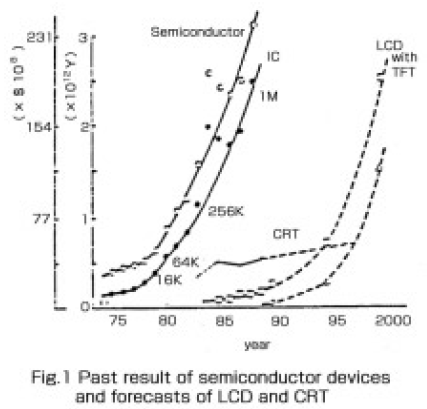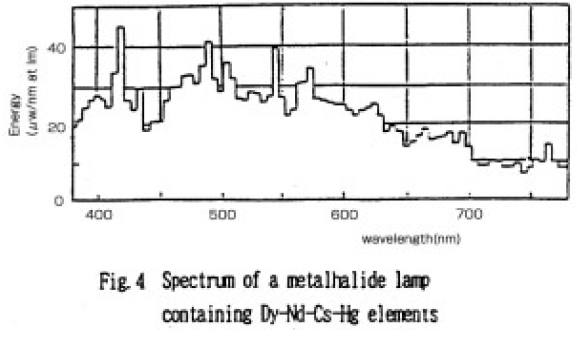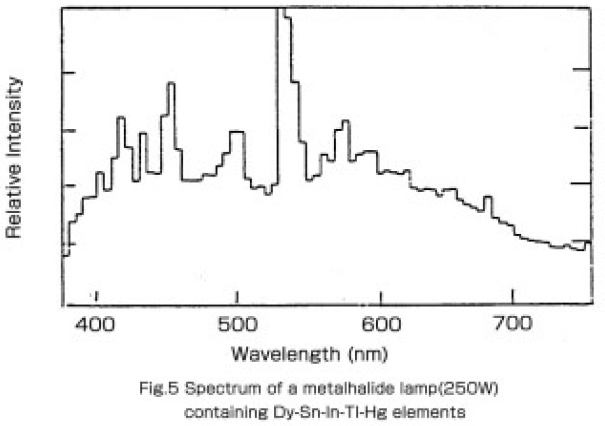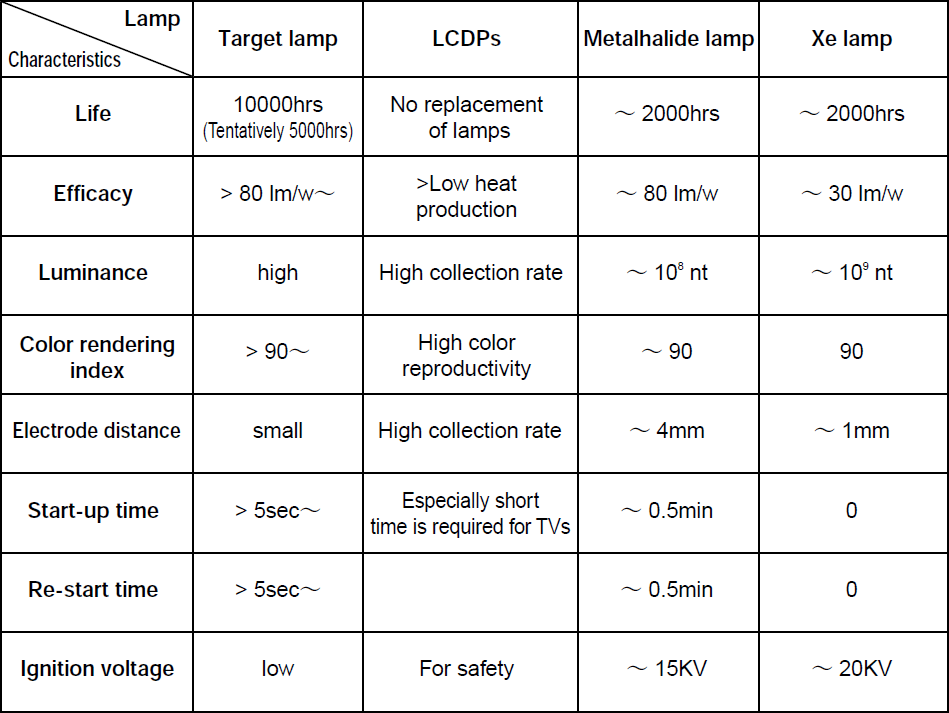光技術情報誌「ライトエッジ」No.2/特集 液晶バックライト光源(1995年春発行)
THE 6TH INTERNATIONAL SYMPOSIUM ON THE SCIENCE & TECHNOLOGY OF LIGHT SOURCES Invited
Papers and Abstracts P.275~284
(1992年)
COMPACT HID LAMPS FOR LIQUID CRYSTAL PROJECTORS
Tatsumi Hiramoto
Ushio Inc.
2-6-1 Ohtemachi,Chiyodaku,Tokyo,Japan
1. Introduction
In these ten years liquid crystal displays(LCDs) were developed for various uses with making best use of their outstanding merits of small size in thickness and lightness.Especially, liquid crystal light valves with thin film transistors(TFT) have recently emerged on the scens. LCDs with TFT have made the image quality of LCDs equal to that of the conventional cathode-ray tubes(CRTs).
The size of the LCDs is distributed from 0.7 inch for a view-finder of vide cameras to 14 inches for office automation machines(OAs). These are used as the direct-view type displays. Small size-fluorescent lamps are used in the above applications as back-light sources.
The LCDs are used otherwise as light valves of image projection system, in which electronic signal control ONOFF of the light valves, and the image is optically enlarged and projected on a screen. Although the present LC panel size is 1.3 to 5.5 inches, the screen size covers 25 to 100 inches. Compact HID lamps are adopted as the projection light sources. The electronic signals are those of the video, television or others.As the optical principal is same for all signal modes, the term “LCD Projectors (LCDPs)” will be representatively used in the present paper. The LCDPs are now in an infant stage. Further development is essential in order to reach the growth stage.
Some market forecasts of LCDs and LCDPs are given first of all in this paper. Then, requirements for lamps from LCDPs are described.Problems on lamps to be solved in the near future are finally explained.
2. Market forecasts of LCDs
Most of LCDs are produced in Japan and supplied to world-wide countries at present.Figure 1 shows the forecasts of production amount of LCDs in comparison with the historical trends of semiconductor devices and ICs(1).It is expected that LCDs run after semiconductor devices with the time lag of about 15 years. Prospective trends in major application fields are shown in Fig.2 (1). In 1995 the use for TV will share 20% of the total market.


Two types of the LCDPs have been published:front type and rear type. In the latter,image is shown with transmitted light through the screen. On the contrary,in the front type image is given with reflected light on the screen. Another forecast gives the trend of projection displays in Fig.3(2). The front type LCDPs expand their market . The rear type LCDPs will gradually invade the share of the CRT rear type projection TVs . Although the share of the rear type LCDPs is still low in 1995 as seen in Fig.3,this will be dominant at the beginning of the next century,since this will be able to become a home‐use TV with a large screen,due to compactness and lightness.

As shown in Fig.1 to 3 some optimistic forecasts have been done on the growth of LCDs and LCDPs. These forecasts are based upon the prospects of successful future development of constituent technologies. Lamp technology is one of them.
3.Requirements for lamps and problems on the present lamps
(a)Present status of the lamps
A metalhalide burner is combined with a dichroic parabolic mirror to form a lamp.Metalhalide lamps with 150W input power are mainly used at present, in the projectors with a medium number of pixels. However, 250W metalhalide lamps are adopted for HDTVs and HD-projectors with LC panels of a larger number of pixels such as 1.2× 106 , because the transmittance of the LC light valves decreases with the increase in the density.The rear-type TVs need higher screen brightness and use 250W metalhalide lamps, since they are set in brighter rooms. The electode distances(arc length) of such metalhalide lamps are designed to be about half centimeter to increase both of an arc luminance and an optical collection rate of a parallel light beam incident on LCD panels. The lamps are operated at the one of the horizontal or vertical position with an electrode-stabilized arc.
Filling elements into the lamps are Dy, Nd and Cs or Li with Hg for a group of the lamps(3). In another group, the filling elements are Sn, Dy , In, Tl and Hg(4).
In both groups the efficacy is about 80lm/W and Ra is 80 to 90. The color temperature of the lamp is adjusted to a spectral property of the dichroic mirrors for the color separation in LCDs. The typical spectra of the first and the second groups of the lamps are shown in Fig.4(3) and 5(4) respectively. The color reproductivity and efficacy of the spectra are good for the present metalhalide lamps.


Lamp life is nearly 2000 hours for both types, which is very short compared with one required by LCDP engineers. Behaviors of electrode-stabilized metalhalide lamps are not sufficiently known. A method for estimating the spectrum of the electrode-stabilized arc with use of 2-step temperature distribution model has been proposed for lasmas composed of multi-filling elements(5).
(b) Requirements and related problems
The characteristics of a target lamp required by engineers of LCDs are given in Table 1 in comparison with those of a metalhalide lamp used in LCDPs and a Xe lamp. The most important problem to be solved on the way to the target lamp is how to lengthen the lamp life. It is absolutely necessary for the lamp life to compete with that of CRTs, about 10000 hours or longer, in order for LCDPs to gorow home-use TVs. However, as this goal is too far,it is better to settle upon a tentative goal before reaching the final goal. The life of 5000 hours may be reasonable. The phenomenon at the life end is the reduction in screen-brightness, 50% of the initial value. This comes mainly from the decrease in the optical collection rate of the parallel light beam due to a deterioration of the inner surface of the vitreous quartz envelop. In order to increase the color reproductivity and efficacy of lamps, the envelope temperature is kept high, e.g.near 1000°C in the metalhalide lamps used now in the LCDPs. It is well known that the devitrification due to some rare-earth elements proceeds acceleratedly with the rise of the envelope temperature. Developmental efforts should be made in order to solve this problem. The followings may give the key points:

Table 1 Characteristics of the target, present metalhalide, and Xe lamps
Higher luminance and shorter electrode distance bring about a higher optical collection rate of a parallel beam.
- (1)Enhancement of a spectrum in special wavelength regions and increase of efficacy, with adding some emissive species(4, 6).
- (2)Ceramic envelope(10)Saphire envelope may be better for this application, although poly-crystalline alumina is experimentally used in the reference(7).
- (3)Coating the inner surface of the vitreous quartz envelope with chemically resistive materials
- (4)Investigation on new rare-earth halide complexes possessing higher vapor pressure.
The second problem is how to increase the rate of the optical collection of the parallel beam incident on LC panels. As seen in Table 2, the rate is relatively low. This may be increased by shortening the electode distance or designing a non-parabolic mirror. When the distance becomes small, the region of the cathode spot dominates the whole volume of the arc. As the sport temperature becomes higher, the spectral lines of mercury become strong, but the lines of rare-earth elements, Which have relatively low excitation levels do not become so strong as mercury lines. Anyway, shortening of the electode distance will cause unfavorable spectrum similar to that of mercury, and a power supply of high current. Since the parallel light beam is essential for a present twist-nematic LC and a polymer dispersion LCDs underdevelopment, one should search for favorable spectra of short arcs. On should utilize the merit of a high temperature of the spot. A Xe short-arc lamp is well known to emit a continuous spectrum which is favorable for this application. Moreover, as shown in Fig.6, the luminance of the cathode spot is very high compared with that of metahalide lamps adopted in LCDPs(8). Xe-based short-arc metalhalide lamps many have one possibility.

Table 2 Light transmittance through each component of an LCDPTV


The third problem is color difference on the screen. This is solved by raising the vapor presure of the emitting species(9). Start-up time and re-start time are required to be short especially for TVs, because ones are used to operate the conventional TVs without any trouble on these times.
Another big problem is a drastic improvement on the low transmittance of LCDs shown in Table 2. New LCDs should be developed. One example is a polymer dispersion LCDs, which have no polarizer(10). These displays are promising as LCDPs, since the light transmittance becomes three times higer effectively in comparison with the present one. An optical system converting one of polarized component of the light into another component has been demonstrated. This may double utilization rate of the light beam incident on the polarizer.
Conclusion
At present, LCD projectors are in the infant stage. Lamp technology has a key point for them to grow further.
The most important item of developing lamps for this application is lengthening the lamp life from 2000 at present to about 10000 hours without any deterioration in color reproductivity.
Next item is increasing the rate of the optical collection of the parallel light beam. At last, it is essential for lamp development that lamp scientists and engineers should do research and development in cooperation with engineears developing LCDPs.


![ライトエッジ No.2 [特集号]液晶バックライト光源](./content_file/file/lightedge_01_21.png?_size=1)